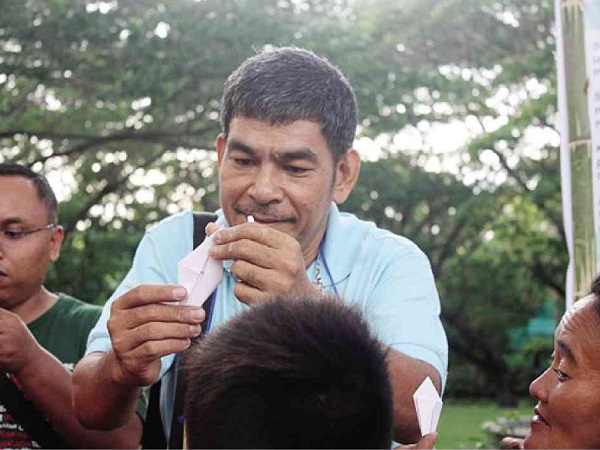Activist finds origami a creative way to campaign in elections

BAYANI Cambronero use the origami to promote the candidacy of senatorial candidate Teddy Casiño. Photo by MARICAR CINCO
When activist Bayani Cambronero fell in love with origami almost 20 years ago, he never imagined that it would one day become a medium to carry the message for an independent senatorial candidate he avidly supports—Teddy Casiño.
Cambronero has little money to go around and only sheer will to wage a campaign, so he decided to use imagination and innovation along Casiño’s campaign trail. He gives a 10-minute “side show” of the Japanese art of paper folding that he is equally passionate about.
On his chest hangs a placard that read: “A million peace cranes for Casiño to win the Senate campaign.” The crane is the most popular design of origami.
“It is believed that a thousand peace cranes folded will grant one his wish. My wish is for Teddy to win,” Cambronero said, referring to the Japanese myth and the story of Sadako Sasaki, the girl who folded paper cranes as she battled an illness caused by the 1945 Hiroshima bombing.
Symbolic
Article continues after this advertisementOf course, the “million” was only “symbolic,” Cambronero stressed, “as it is hard to keep count of the peace cranes that I ask people to continue doing at home.”
Article continues after this advertisement“What’s important is to personally introduce to people who Teddy is and explain what his platforms are, rather than just handing out pamphlets or playing the campaign jingle to them,” he added.
Cambronero was working with the Benedictine missionaries at the St. Scholastica congregation in Pasay City in 1994 when he became fascinated with origami. He found it therapeutic for children and people with illnesses.
Murder charges
“Origami helps people reflect and think clearly. To some cancer patients, it helps ease their pain,” he said.
Origami also accompanied him through his dark days in 2006 when he and 71 other political activists faced murder charges in connection with an ambush of government troops by the communist New People’s Army in Oriental Mindoro. He decried the charges as “fabricated” as most of the activists were political leaders and not NPA members.
The case forced the accused to “lie low.” Cambronero sought refuge with a religious group in an undisclosed location until the court dismissed it in 2011.
Now 53, Cambronero has never gone out without reams of used paper which he collects from print shops. He would invite people in small crowds to help make paper cranes while telling them about Casiño, the lone candidate of the Makabayan coalition in the 2013 polls.
Cambronero, who hails from Calamba City in Laguna, is Makabayan’s spokesperson in Southern Tagalog. He was the eighth nominee of the Bayan Muna party-list group, which won three seats in the 13th Congress.
Origami, the activist said, was a “nontraditional form of campaigning.” He cited pluses and minuses.
Positive feedback
“Some people think I’m a hoax specially before I started wearing that placard or that I’m trying to sell them something once I approach them,” Cambronero said.
But the community’s feedback has more often been positive. “For instance, when we reach the step when the paper should be folded into a triangle, I would say it should be like in the song, ‘Tatsulok.’ Then they start asking: ‘Isn’t that antipolitician?’” he narrated.
He would then raise the triangle and explain the lyrics of the ’80s song about the few rich people on top of society.
He would also ask his audience to make sure the paper is folded equally on all sides, just like how Casiño promises equal opportunities should he win in the Senate race.
Short of funds, Cambronero said the campaign team was encouraged to be more “creative” in ways of making voters remember Casiño.
“It’s different from vote-buying or giving voters something instant with financial value. What I try to impart to people is an added knowledge,” he said. Maricar Cinco